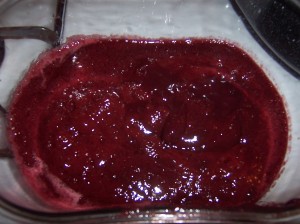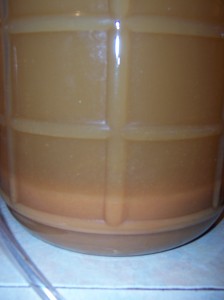Tonight is Yule, 2013, otherwise known as the winter solstice, which means it is the longest night of the year. On this night it is traditional for our ancestors to stay up all night, often in quiet contemplation, while awaiting the return of the light at dawn. In addition, where I live there is an ice storm coming. There isn’t much happening yet as I write this, but there is been a bit of rain most of the day, which will continue and get more intense as the temperature drops. By the time the storm is done on Monday we could have up to 1″ of ice coating everything outside. In short, a great night to make up some mead.
It’s blackberry cyser time. Last year I made the blackberry cyser with cranberries, and while it was good I thought that the tartness from the cranberries mixed with the tartness of the cider was a bit much. So this year I used more blackberries and no cranberries. The blackberries grew in our yard and were picked as they ripened throughout the summer. I froze 2 quarts of them for meadmaking, and thawed them out before juicing:

The juice was as vibrant as ever, and it eliminated the problem of seeds getting into the mead:

I also got 3 gallons of fresh pressed and untreated apple cider from Thompson’s Orchard near my home. The cider sat for a couple of days before I used it, and in that time a bit of sediment formed at the bottom of the carboy:

I decided to take advantage of this settlement and I siphoned the clear(er) cider out of the carboy, leaving the sediment behind. This way I should have a bit less sediment at the end of my mead fermentation.
I mixed 2 batches of this cyser tonight, in 2 different 3-gallon carboys, one batch at a time using half of the ingredients. I ended up using about 1.25 gallons of cider, 0.75 gallons of Star Thistle Honey (I wrote about this fantastic honey in my previous post Star Thistle Mead), about 2 cups of black tea (for the tannins), topping it off with spring water to get me to three gallons, and a 17% initial alcohol potential.
Lalvin Rhone 4600 Yeast
One interesting note with this batch is that I am using a different yeast than I normally use. I love the Red Star Montrachet yeast that I have used in the vast majority of my meads, but Phil over at The Honey Exchange was excited about this yeast and hooked me up with a bit of it to experiment with. The Lalvin Rhone 4600 yeast is very similar to Montrachet, but is apparently common with commercial wineries. According to one of the sellers,
Lalvin Rhône 4600® was selected by Inter-Rhône’s technical department after three years of research.The purpose of the study was to select a strain, which would be particulary suited for the production of elegant and fruity white wines, but also being appropriate for rosé wines. Lalvin Rhône 4600® has the qualities required to successfully ferment musts with high sugar and low assimilable nitrogen contents, and a high alcohol tolerance.It enhances wine fruitiness with pineapple and apricot aromas.
In short, have 6 gallons of beautiful cyser ready for primary fermentation:

I can’t wait to see how this comes out with the new yeast and the tweaked recipe!
